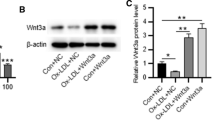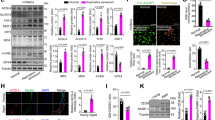Abstract
Hyperlipidemia is an important factor in the induction of cardiovascular diseases. However, the molecular mechanisms underlying the vascular injury involved in hyperlipidemia remains unclear. This study aimed to investigate the Notch pathway of endothelial progenitor cells (EPCs) in reendothelialization after vascular injury and to explore the involvement of Notch pathway in the senescence of EPCs. Our results demonstrated that high-fat diet (HFD) treatment inhibited reendothelialization after vascular injury in the mice model. In vitro studies showed that 7-ketocholesterol (7-keto) stimulation induced senescence in the isolated EPCs from mice. In addition, 7-keto markedly upregulated the protein expression of Notch1 and Delta-like ligand 4 and induced the transport of notch intracellular domain (NICD) to the nucleus. Mechanistically, treatment with NICD inhibitor reduced the senescence of the EPCs stimulated by cholesterol. In summary, our results showed that HFD treatment caused the disruption of reendothelialization after vascular injury in the mouse model. In vitro studies indicated that 7-keto-induced senescence of EPCs was at least via the activation of the Notch1 pathway. Mechanistic data suggested that 7-keto may activate the Notch1 pathway by regulating the generation and transport of NICD to the nucleus. Future investigations are warranted to confirm the role of Notch1 in the dysfunction of EPCs during obesity.





Similar content being viewed by others
References
Karr S (2017) Epidemiology and management of hyperlipidemia. Am J Manag Care 23(9 Suppl):S139–s148
Watanabe S, Kumazaki S, Kusunoki K, Inoue T, Maeda Y, Usui S, Shinohata R, Ohtsuki T, Hirohata S, Kusachi S, Kitamori K, Mori M, Yamori Y, Oka H (2018) A high-fat and high-cholesterol diet induces cardiac fibrosis, vascular endothelial, and left ventricular diastolic dysfunction in SHRSP5/Dmcr rats. J Atheroscler Thromb 25(5):439–453. https://doi.org/10.5551/jat.40956
Kiewisz J, Kaczmarek MM, Pawlowska A, Kmiec Z, Stompor T (2016) Endothelial progenitor cells participation in cardiovascular and kidney diseases: a systematic review. Acta Biochim Pol 63(3):475–482. https://doi.org/10.18388/abp.2016_1284
Asahara T, Kawamoto A (2004) Endothelial progenitor cells for postnatal vasculogenesis. Am J Physiol Cell Physiol 287(3):C572–C579. https://doi.org/10.1152/ajpcell.00330.2003
King, T. F., & McDermott, J. H. (2014). Endothelial progenitor cells and cardiovascular disease. J Stem Cells, 9(2), 93-106, doi:jsc.2014.9.2.93
Ii M, Takeshita K, Ibusuki K, Luedemann C, Wecker A, Eaton E, Thorne T, Asahara T, Liao JK, Losordo DW (2010) Notch signaling regulates endothelial progenitor cell activity during recovery from arterial injury in hypercholesterolemic mice. Circulation 121(9):1104–1112. https://doi.org/10.1161/CIRCULATIONAHA.105.553917
Nishio E, Arimura S, Watanabe Y (1996) Oxidized LDL induces apoptosis in cultured smooth muscle cells: a possible role for 7-ketocholesterol. Biochem Biophys Res Commun 223(2):413–418. https://doi.org/10.1006/bbrc.1996.0907
Baeten JT, Lilly B (2017) Notch signaling in vascular smooth muscle cells. Adv Pharmacol 78:351–382. https://doi.org/10.1016/bs.apha.2016.07.002
Kwon SM, Alev C, Asahara T (2009) The role of notch signaling in endothelial progenitor cell biology. Trends Cardiovasc Med 19(5):170–173. https://doi.org/10.1016/j.tcm.2009.10.002
Zhu X, Ding S, Qiu C, Shi Y, Song L, Wang Y, Wang Y, Li J, Wang Y, Sun Y, Qin L, Chen J, Simons M, Min W, Yu L (2017) SUMOylation negatively regulates angiogenesis by targeting endothelial NOTCH signaling. Circ Res 121(6):636–649. https://doi.org/10.1161/circresaha.117.310696
Ma FX, Zhou B, Chen Z, Ren Q, Lu SH, Sawamura T, Han ZC (2006) Oxidized low density lipoprotein impairs endothelial progenitor cells by regulation of endothelial nitric oxide synthase. J Lipid Res 47(6):1227–1237. https://doi.org/10.1194/jlr.M500507-JLR200
Lindner V, Fingerle J, Reidy MA (1993) Mouse model of arterial injury. Circ Res 73(5):792–796
Gary RK, Kindell SM (2005) Quantitative assay of senescence-associated beta-galactosidase activity in mammalian cell extracts. Anal Biochem 343(2):329–334. https://doi.org/10.1016/j.ab.2005.06.003
Rosenbaum MA, Miyazaki K, Graham LM (2012) Hypercholesterolemia and oxidative stress inhibit endothelial cell healing after arterial injury. J Vasc Surg 55(2):489–496. https://doi.org/10.1016/j.jvs.2011.07.081
Pu DR, Liu L (2008) HDL slowing down endothelial progenitor cells senescence: a novel anti-atherogenic property of HDL. Med Hypotheses 70(2):338–342. https://doi.org/10.1016/j.mehy.2007.05.025
De Biase C, De Rosa R, Luciano R, De Luca S, Capuano E, Trimarco B et al (2013) Effects of physical activity on endothelial progenitor cells (EPCs). Front Physiol 4:414. https://doi.org/10.3389/fphys.2013.00414
Imanishi T, Tsujioka H, Akasaka T (2008) Endothelial progenitor cells dysfunction and senescence: contribution to oxidative stress. Curr Cardiol Rev 4(4):275–286. https://doi.org/10.2174/157340308786349435
Pantke U, Volk T, Schmutzler M, Kox WJ, Sitte N, Grune T (1999) Oxidized proteins as a marker of oxidative stress during coronary heart surgery. Free Radic Biol Med 27(9–10):1080–1086. https://doi.org/10.1016/s0891-5849(99)00144-6
Wooten JS, Wu H, Raya J, Perrard XD, Gaubatz J, Hoogeveen RC (2014) The influence of an obesogenic diet on Oxysterol metabolism in C57BL/6J mice. Cholesterol 2014:843468–843411. https://doi.org/10.1155/2014/843468
Song J, Wang D, Chen H, Huang X, Zhong Y, Jiang N, Chen C, Xia M (2017) Association of Plasma 7-Ketocholesterol with cardiovascular outcomes and Total mortality in patients with coronary artery disease. Circ Res 120(10):1622–1631. https://doi.org/10.1161/circresaha.117.311049
Russell JS, Brown JM (2014) Circulating mouse Flk1+/c-kit+/CD45- cells function as endothelial progenitors cells (EPCs) and stimulate the growth of human tumor xenografts. Mol Cancer 13:177. https://doi.org/10.1186/1476-4598-13-177
Fadini GP, Losordo D, Dimmeler S (2012) Critical reevaluation of endothelial progenitor cell phenotypes for therapeutic and diagnostic use. Circ Res 110(4):624–637. https://doi.org/10.1161/circresaha.111.243386
Shen X, Zhou Y, Bi X, Zhang J, Fu G, Zheng H (2015) Stromal cell-derived factor-1alpha prevents endothelial progenitor cells senescence and enhances re-endothelialization of injured arteries via human telomerase reverse transcriptase. Cell Biol Int 39(8):962–971. https://doi.org/10.1002/cbin.10471
Tominaga T, Shimada R, Okada Y, Kawamata T, Kibayashi K (2019) Senescence-associated-β-galactosidase staining following traumatic brain injury in the mouse cerebrum. PLoS One 14(3):e0213673. https://doi.org/10.1371/journal.pone.0213673
Johmura Y, Shimada M, Misaki T, Naiki-Ito A, Miyoshi H, Motoyama N, Ohtani N, Hara E, Nakamura M, Morita A, Takahashi S, Nakanishi M (2014) Necessary and sufficient role for a mitosis skip in senescence induction. Mol Cell 55(1):73–84. https://doi.org/10.1016/j.molcel.2014.05.003
Koyanagi M, Bushoven P, Iwasaki M, Urbich C, Zeiher AM, Dimmeler S (2007) Notch signaling contributes to the expression of cardiac markers in human circulating progenitor cells. Circ Res 101(11):1139–1145. https://doi.org/10.1161/CIRCRESAHA.107.151381
Acknowledgments
The study was supported by Shenzhen Healthcare Research Project (SZBC2017007), Natural Science Foundation of Guangdong Province of China (2016A030313248), Science and Technology project of Guangzhou city of China (201604020129).
Author information
Authors and Affiliations
Corresponding authors
Additional information
Publisher’s note
Springer Nature remains neutral with regard to jurisdictional claims in published maps and institutional affiliations.
Electronic supplementary material
Supplemental Figure S1
Schematic drawings of the in vivo and in vitro experimental procedures. (PNG 666 kb)
Supplementary Figure S2
Effects of 7-keto and DAPT on EPCs viability. The EPCs were stimulated with 7-keto (0, 5,10,20 μM) and then treated with Notch pathway inhibitor, DAPT (10 μM) for 7 days. (A, B) The cytotoxic effects on EPCs were assessed by CCK-8 assay. Both 7-keto and DAPT showed no cytotoxic effects on EPCs. N = 3. (PNG 83 kb)
Rights and permissions
About this article
Cite this article
Liang, J., Ke, X., Yang, R. et al. Notch pathway activation mediated the senescence of endothelial progenitor cells in hypercholesterolemic mice. J Bioenerg Biomembr 52, 431–440 (2020). https://doi.org/10.1007/s10863-020-09853-5
Received:
Accepted:
Published:
Issue Date:
DOI: https://doi.org/10.1007/s10863-020-09853-5




